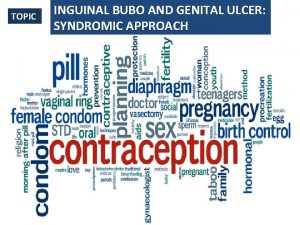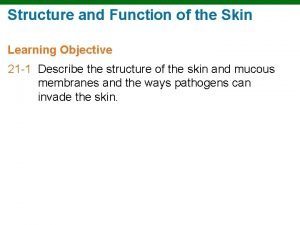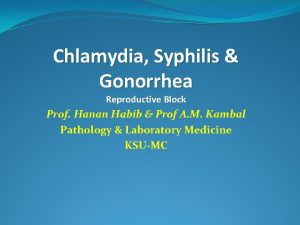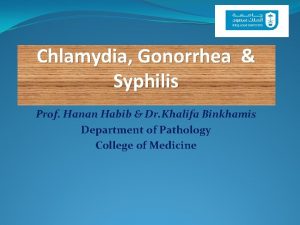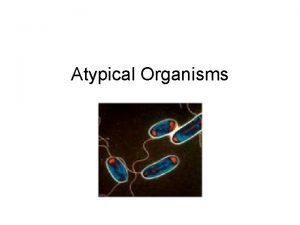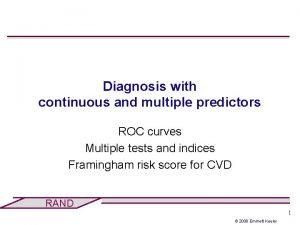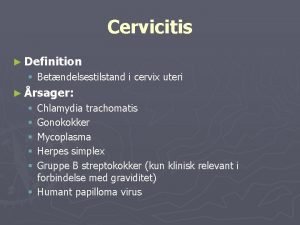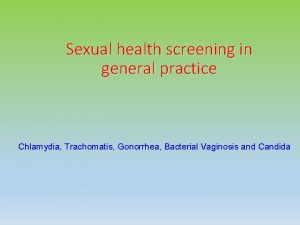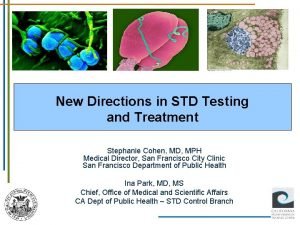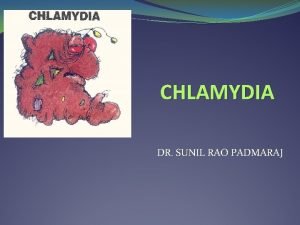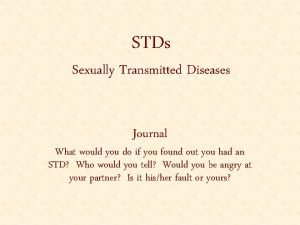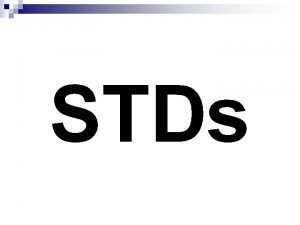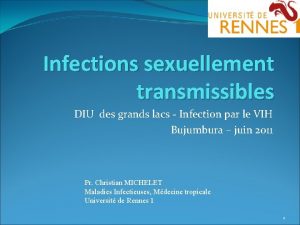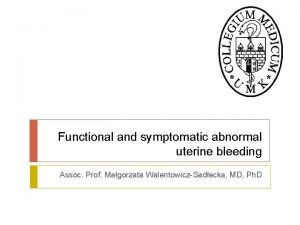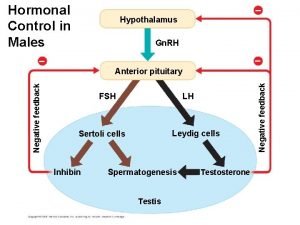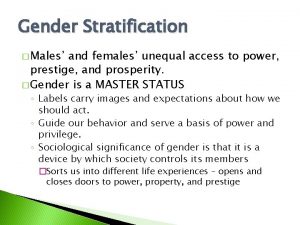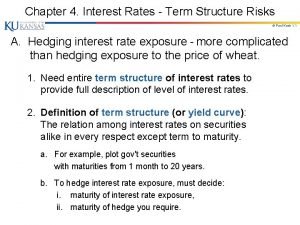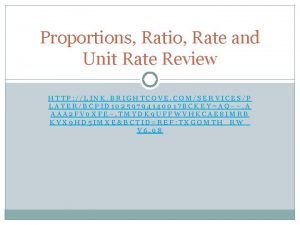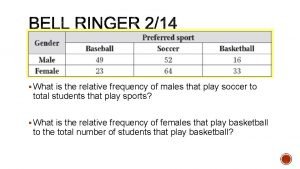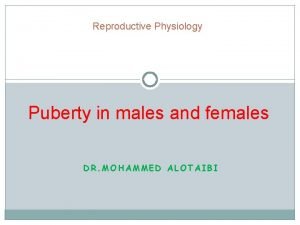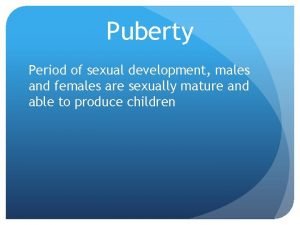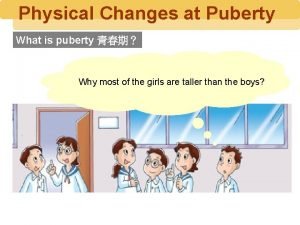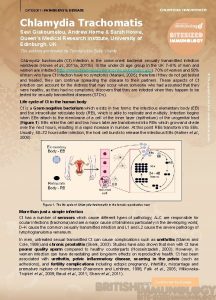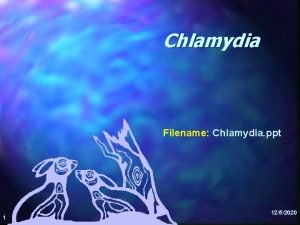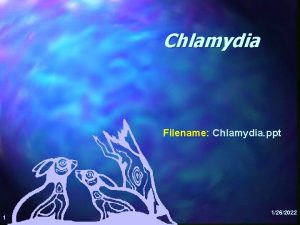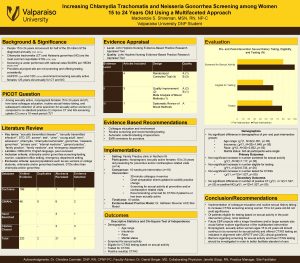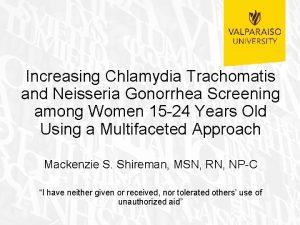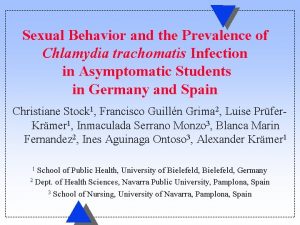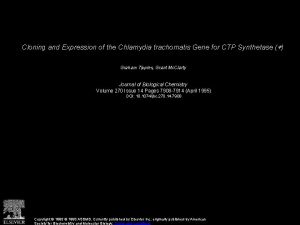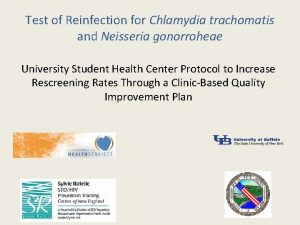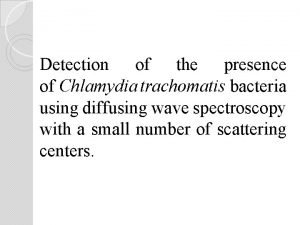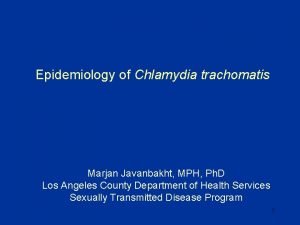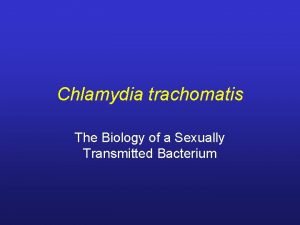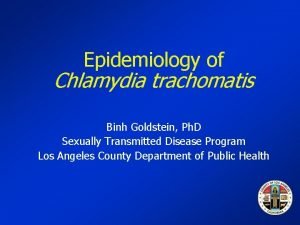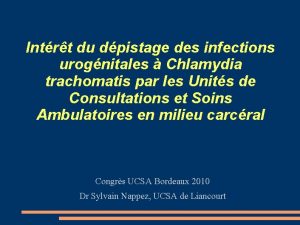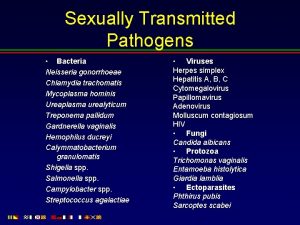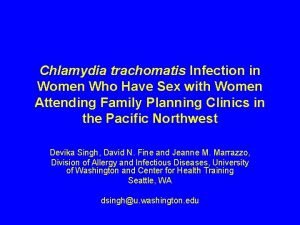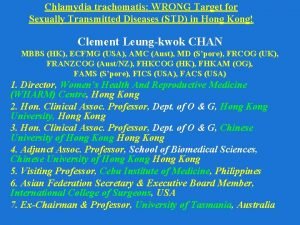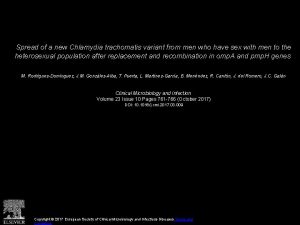Repeat Chlamydia trachomatis Rate and Predictors among Males





























- Slides: 29

Repeat Chlamydia trachomatis: Rate and Predictors among Males Eileen F. Dunne M. D. , M. P. H. JB Chapin, C Rietmeijer , CK Kent, J Ellen, C Gaydos, N Willard, L Lloyd, N Birkjukow, S Chung, JA Schillinger, LE Markowitz Division of STD Prevention Centers for Disease Control and Prevention

Acknowledgments Baltimore: Jon Ellen Charlotte Gaydos Nancy Willard Michelle Chung Denver: Kees Rietmeijer Laura Lloyd San Francisco: Charlotte Kent Nat Birkjukow CDC: Julie Schillinger Lauri Markowitz Maya Sternberg Johanna Chapin

Background • Chlamydia trachomatis (Ct) infection in females is common and associated with serious sequelae – PID, ectopic pregnancy and infertility • Ct infection in males – Limited resources to screen – Additional information needed to guide program activities

Background • Male Chlamydia Screening Project: – Demonstration project: men ages 15 -44 screened for Ct infection • Baltimore • Denver • San Francisco • Seattle – Longitudinal Study: men with Ct infection recruited for a study of repeat infection • Baltimore • Denver • San Francisco

Venue Type Baltimore (N=10) Denver (N=33) X X X Adult Primary Care X X Juvenile Detention X X Adolescent Primary Care San Francisco (N=11) Adult Detention X X X School Clinics X X X School Health Fairs X College Clinics X Community Based Organizations X Drug Treatment X STD Clinics X X Street Outreach X X

Objectives To evaluate: • • Ct prevalence and predictors of infection Cost-effectiveness of screening for Ct infection Partner and network characteristics Rate and predictors of repeat Ct infection

Objectives • • Ct prevalence and predictors of infection Cost-effectiveness of screening for Ct infection Partner and network characteristics Rate and predictors of repeat Ct infection

Longitudinal Study Methods • Men with Ct infection recruited from various venues in Baltimore, Denver, San Francisco – Study Design • Baseline Visit – Questionnaire – Partner management • Follow-up at 1 and 4 months – Screening for Ct using urine NAATs – Questionnaire – Partner management

Longitudinal Study Methods • Analysis: – Men with at least one follow-up visit – Repeat infection: defined as Ct infection at the first or second follow-up visit

Longitudinal Study Methods • Bivariate • Characteristics of men at baseline visit • Characteristics of partners – Baseline partners – New partners • Cox Proportional Hazards Model

Longitudinal Study Enrollment 358 men enrolled 272 (76%) study population 98 (36%) 1 follow-up visit 174 (64%) 2 follow-up visits

Time in Study Median Range Time to First Follow-up 33 days 21 -215 days Time in Study 102 days 21 -391 days

Partner Management • 272 study population – 403 partners named • 74 (18%) partners locatable • 65 (16%) partners treated Locatable Treated

Study Population Characteristic Age (yrs) 15 -17 18 -19 20 -24 >24 Race/Ethnicity White Hispanic Black Other City Baltimore Denver San Francisco N (%) 51 63 96 61 (19) (23) (35) (23) 49 77 108 37 (18) (29) (40) (13) 58 (21) 138 (51) 75 (28)

Repeat Infection • Overall: 31 (11%) men had repeat Ct infection – 3 men ≥ 1 repeat infection

Repeat Infection by City N Repeat Infection n (%) Baltimore Denver 58 138 7 (12) 16 (12) San Francisco 75 8 (11)

Repeat Infection by City/Venue N Repeat Infection n (%) Baltimore/Adolescent Clinics 18 5 (28) Baltimore/School Clinics Denver/Adolescent Clinics 40 32 2 9 (5) (28) Denver/STD Clinic 67 5 (7) San Francisco/STD Clinic 57 7 (12)

Repeat Infection by Age Variable N Repeat infection n (%) p value Age (yrs) 15 -17 18 -19 20 -24 >24 51 63 96 61 9 (18) 6 (10) 10 (10) 6 (10) . 22

Repeat Infection by Partner Characteristic N Repeat infection n (%) # Partners last 2 months 0 1 -2 ≥ 3 12 210 45 0 27 (13) 4 (9) New Partner during study Yes No 111 16 (14) 16 (10)

Repeat Infection by Partner Type Partners during study No partners Only baseline partners Baseline and new partners Only new partners N 5 155 104 8 Repeat infection n (%) 0 15 (10) 16 (15) 0

Repeat Infection Significant findings Variable Education level <HS Some HS College Graduate school History of STD Yes No Income No Yes N Repeat infection p value n (%) 21 136 89 15 7 10 8 2 (33) (7) (9) (13) . 003 67 204 13 18 (19) (9) . 01 97 174 16 15 (16) (9) . 05

Cox Proportional Hazards Model Variable Hazard Ratio (95% CI) p value Education level <HS more than HS 5. 1 1. 0 (2. 1, 12. 5) <. 001 History of STD Yes No 2. 4 1. 0 (1. 1, 5. 4) . 03 Income No Yes 1. 8 1. 0 (0. 8, 3. 9) . 14

Incidence of Repeat Infection • Cumulative Incidence: 42. 3 per 100 person years – Most infections occurred early

Cumulative Incidence Curve

Conclusions • Repeat Ct infection among men from diverse geographic locations was 11% • Partner characteristics were not significantly associated with repeat infection • History of STD, and less than high school education were associated with repeat Ct infection

Future Directions • Genotyping • Evaluating partner characteristics and sexual behaviors during study

Contact • Eileen F. Dunne (edunne@cdc. gov) – 404 -639 -6184

Acknowledgments Baltimore: Jon Ellen Charlotte Gaydos Nancy Willard Michelle Chung Denver: Kees Rietmeijer Laura Lloyd Stewart Thomas San Francisco: Charlotte Kent Nat Birkjukow Seatle Jeanne Marrazzo CDC: Julie Schillinger Lauri Markowitz Maya Sternberg Johanna Chapin John Papp Angelica Wendt

Survival Curve
 Chlamydia trachomatis
Chlamydia trachomatis Chlamydia trachomatis
Chlamydia trachomatis Chlamydia trachomatis diagnosis
Chlamydia trachomatis diagnosis Chlamydia trachomatis diagnosis
Chlamydia trachomatis diagnosis Giemsa stain
Giemsa stain Roc curve with multiple predictors
Roc curve with multiple predictors Pondocilin
Pondocilin Grey cloudy discharge
Grey cloudy discharge Std crabs pics
Std crabs pics 2g azithromycin syphilis
2g azithromycin syphilis Biovar tric
Biovar tric Chlamydia symptoms
Chlamydia symptoms Pid discharge pictures
Pid discharge pictures Gonorrhea curable
Gonorrhea curable Mst symptômes photos
Mst symptômes photos Palm coein acog
Palm coein acog How is meiosis different in males and females
How is meiosis different in males and females Hypothalamus
Hypothalamus The unequal access of males and females to property
The unequal access of males and females to property Real vs nominal interest rate
Real vs nominal interest rate Plant growth index
Plant growth index Oas spread
Oas spread Spot rate and forward rate
Spot rate and forward rate Unit rate proportions
Unit rate proportions What is the relative frequency for males ?
What is the relative frequency for males ? Carey stainer
Carey stainer Thelarche adalah
Thelarche adalah Male puberty
Male puberty Porque dos males ha hecho mi pueblo me dejaron mí
Porque dos males ha hecho mi pueblo me dejaron mí Urethra
Urethra
